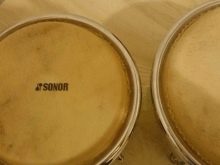Bongo musical instrument

Bongos are two small drums of different sizes combined into one set. Such a percussion musical instrument is, most likely, a native of Africa, which eventually gained popularity in the provinces of Cuba and some Latin American countries. The bongo is not an academic instrument, so experimentation is possible when playing it.
History
There is no exact data on the origin of the bongo. Most experts are inclined to believe that his homeland is in Africa, since similar drums appeared among some African tribes in the 12th century.
Given the fact that the bongo was first used in one of the provinces of Cuba at the end of the 19th century, this instrument is often called Afro-Cuban. At that time, the bongo was in demand only in narrow musical circles.
Today, such a pair of drums is often used at concerts of Latin American music in many countries.


Design
A bongo is a pair of small, connected single-headed drums. The diameter of one of the drums is usually 18 cm, and the other is 13. But these sizes are not standard, they can be different if necessary. Body material - wood, metal and plastic.
The membrane (impact coating of the instrument) is made from animal skin or composite materials. Metal nails are used to fix the membrane on the body, which makes them similar to African Congo drums. The bottom of the drum bodies are open, which distinguishes them from the African tbilat drum, which is also considered to be the possible progenitor of the bongo.
An interesting feature of the bongo: its drums were divided according to gender differences. In this case, the big drum is considered female (embra), and the smaller one is considered male (macho).The female drum sounds lower than the male drum.



When playing, the bongo should be between the drummer's knees. If the musician is right-handed, then it is on this side (right) that the female drum should be placed. Today's instruments may have improved diaphragm mounts that allow you to more accurately tune the instrument to the desired tone, which was previously never dreamed of.
Bongo is often found for accompaniment in styles such as bachata, salsa, bossa nova. Later, this type of exotic drums began to be used in reggae and lambada. Experienced musicians can use the unusual sound of bongos in a variety of music. High and clear tone, accelerated rhythmic pattern make this musical instrument quite popular.


How to play?
To extract sound from the drums of this instrument, palms and fingers are used, and sometimes wooden sticks are used.
But the path of a drummer does not begin with this, but with the choice of an instrument. It is recommended for beginners to use the drums with the smallest diameter for training. This will bring the technique to automatism with minimal effort. And you will also need a chair without handles so that nothing hinders movement. The legs should be at right angles, the back should be straight.
It is necessary to sit on the edge of the chair. The bongo is placed between the knees. It is important to place the female drum correctly - from the side of the leading hand, as well as to physically feel that the instrument fits snugly and comfortably.


As already mentioned, the instrument is not academic, so there are simply no clear rules for handling it. Even kneeling the bongos is not a must, you can use the coasters as an alternative. However, there are several recommendations that professionals have developed as a result of many years of practice.
Before starting the game, you need to feel the pulse of the music, as they say, "enter" it. It is perceived intuitively, which comes with experience. But this is not a rhythm or a beat. The pulse must be beaten on the male drum, striking closer to the edge of the membrane. Such actions are called tone. After the blow, the relaxed hand should immediately bounce off, then the sound will be clear and crisp. This cannot be achieved with a strained hand.
Part of the tops of the toes is used when beating the tone. You can add a second hand later. The female drum has a low sound, so it can be easily accentuated in a rhythmic pattern.


Here is a short list of the main hits.
- With an open tone. The upper part of the hand should be hit closer to the edge of the membrane. In this case, the fingers should bounce freely. There are no overtones in an open tone. To change the sound, you can move your fingers backward or forward within a few centimeters of the center of the drum.
- Slap. Lightly tap with your fingers to create an accent. The sound will be louder than when struck normally. After touching the membrane, the fingers must be relaxed so that they bounce off. As a result, the sound will sound higher than when struck with an open tone.
- Heel-toe. It is necessary to place your hand comfortably on the membrane. Use the base of your hand and your fingertips alternately. The hand kind of sways back and forth. With such a blow, the hand is always in contact with the working surface of the drum.
- Basic muted tone. The impact itself is similar to the first, but the fingers should not bounce off the membrane, but remain on it. In this case, the hand relaxes as much as possible (without much movement). The sound will be light, barely audible.


Playing the bongo is creativity. Professionals recommend stretching your fingers before starting, since they are the ones who do the main work. For a start, it is important to simply get into the correct position and comfortably grip the instrument. Further, the musician will select the style of playing strictly for himself and the music he wants to play.










